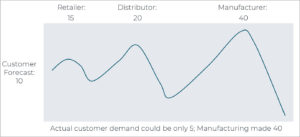You know how the tiniest fluctuations in retail demand can shake up the whole supply chain? That’s the bullwhip effect in action. It’s a supply chain phenomenon where small changes in demand translate to massive fluctuations in demand for wholesales, distributors, manufacturers, and raw material suppliers.
The Bullwhip Effect Explained
One flick of the wrist (change in customer behavior, inaccurate forecasting, order-batching or over-discounting) triggers a wave of disruption that grows the deeper it penetrates the supply chain.
The most common causes of the bullwhip effect are:
- Inaccurate forecasting: customers purchase more of a product; retailers increase inventory to meet demand. The supply chain increases inventory to keep up with a temporary increase in demand, only to be left with excess inventory when the demand falls.
- Order batching: When transportation or product prices fall, some members of the supply chain place one large order rather than multiple small orders in a given time period (aka forward buying). This makes demand difficult for the entire supply chain to predict.
- Over-discounting: Discounts at the retail level often lead to a cycle where demand shifts from high to low at a rapid pace. The aftershock ripples through the entire supply chain.
Here’s how it goes – customer demand shifts for whatever reason. Retailers respond by altering how much product they order from the wholesaler. The wholesaler will act on this shift, increasing orders from the manufacturer to cover the increased demand, plus a little more. The manufacturer will increase production to compensate for the bigger order from the wholesaler. Once again, the manufacturer produces an amount larger than what was ordered as a buffer.
This chain reaction culminates into one big string of increasingly catastrophic inefficiencies. The result? Overinvestment in production, not enough revenue, and – in the worst cases – bankruptcy.
Bullwhip Effect Implications
Victims of the bullwhip effect often end up with excess inventory, even once the demand decreases. This results in higher storage and transportation costs, as well as shipment delays and product spoilage. Combined, the implications of surplus products result in an overall loss of revenue.
What’s the Reverse Bullwhip Effect?
The reverse bullwhip effect happens when price variability originates from the suppliers rather than a shift in customer demand.
How the Pandemic Exacerbated the Bullwhip Effect for Many Companies
At the start of the pandemic, shoppers hoarded everything – hand sanitizer, toilet paper, diet soda, meat and dairy products, and even workout equipment. This massive uptick in demand combined with slowed production/distribution left shelves bare and suppliers grappling for a solution. Nobody knew how long the increased demand (or the pandemic, for that matter) would take to run its course.
Forecasting was made even more difficult at this moment because the increased demand often wasn’t grounded in an increased need. The people emptying grocery store shelves of toilet paper didn’t actually need more toilet paper. The people who couldn’t find toilet paper once the shelves were emptied did need more toilet paper, but only if the people who over purchased continued to repurchase. The sequence of events is hard to follow and was even harder to forecast.
Retailers increased their order sizes, resulting in wholesalers, suppliers and manufacturers doing the same. As we inched up the supply chain, realistic demand became increasingly distorted.
COVID-19 safety precautions limited the extent to which the supply chain could respond and import restrictions made sourcing international materials extremely difficult. This resulted in huge inventory shortages and delayed restock times for retailers all over the world.
Demand went up but actual consumption remained the same. Panic demand resulted in the production of stock that had no buyer. This leads to long-term warehousing and personnel costs as well as decreased revenue generation from low demand, hurting the bottom line.
Inaccurate forecasting even led Amazon to overcompensate on warehouse space throughout the pandemic. Amazon built and bought $2 billion in too much warehouse space and increased third-party FBA fees by 4.3%, citing a fuel and inflation charge.
Tips on How to Mitigate the Bullwhip Effect
The key to mitigating the bullwhip effect is understanding it. The problem starts when retailers rely on immediate sales data to predict increased demand. They request additional product in response to an inaccurate demand forecast, resulting in a series of missteps all the way up the supply chain.
Even if the retailer forecasts demand shifts accurately, trouble can still arise when wholesalers take too long to react. By the time they respond, the moment is often gone. Manufacturers may attribute increased demand in one geographic area to their entire supply chain, creating an even bigger disruption.
So, how can manufacturers prevent this from happening?
Communication
Transparent communication throughout the entire supply chain is vital. The nuances of customer demand must be analyzed and addressed all the way from retailers to manufacturers. Supply chain management software enables this communication through electronic data interchange transactions and project portals.
In-depth, Accurate Forecasting
Accurate forecasting helps beat out the bullwhip effect by revealing how customer demand will present in the near future. Demand sensing, forecasting, inventory optimization and predictive analytics software solutions improve forecasting accuracy.
Demand-driven Approach
A demand-driven approach prioritizes rapid response to supply chain events. It uses technology to achieve supply chain visibility in tandem with transparent communication and accurate forecasting to identify supply chain disruptions and address them in real time.
Wrapping Up
While there isn’t a magic wand to stop the bullwhip effect in its tracks, an agile supply chain can certainly help manage and prevent surprises. Supply chain management software enables the data-driven insights, transparent communication and rapid, demand-driven responses required to stand strong, even when the bullwhip strikes your section of the supply chain.
Ready to reimagine the way you do supply chain planning? Schedule a demo to find out how Arkieva can help you stand your ground the next time you encounter the bullwhip effect in action.






